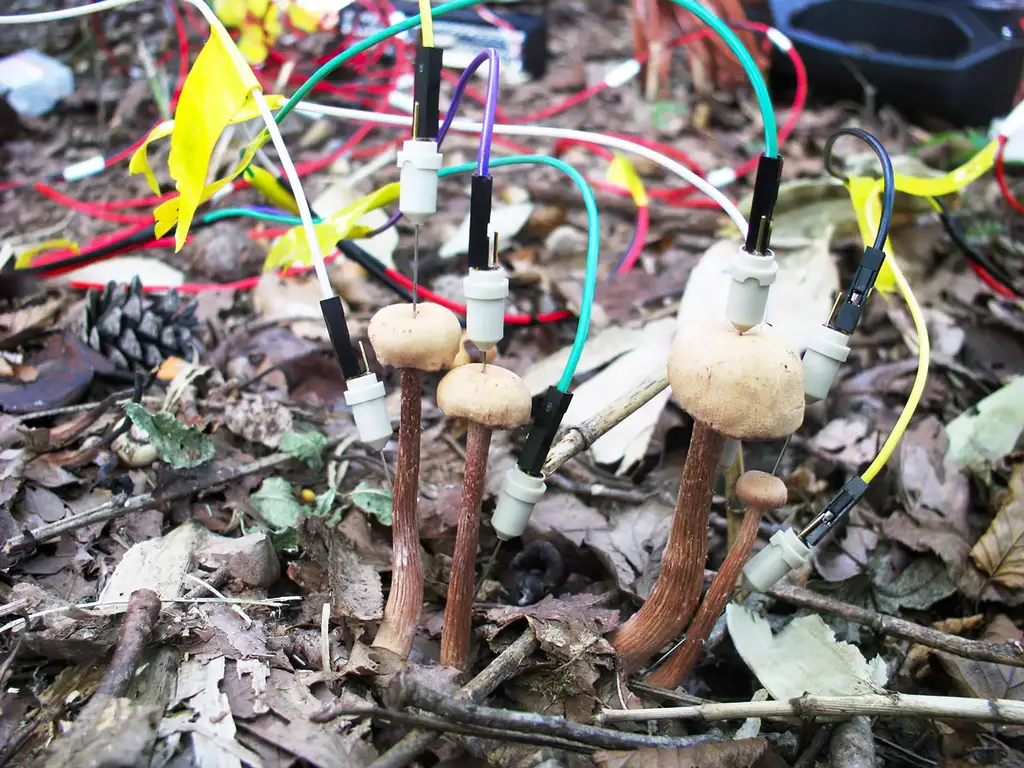

Mushrooms in the field with an electrode attached to the top and bottom. Credit: Yu Fukasawa
A study in the forest on Laccaria bicolor mushrooms, a type of ectomycorrhizal fungi, has revealed that these mushrooms generate fluctuating electrical signals after rainfall, with evidence of signal transport among nearby mushrooms. This finding, which is a departure from previous lab-based studies, suggests the possibility of communication through electrical signals among fungi and potentially with trees, opening new avenues for research in fungal electrical potentials in their natural habitats.
Certain fungi play a critical role in the ecological sustenance of forest trees. Ectomycorrhizal fungi are one such example. Commonly found on pine, oak, and birch trees, ectomycorrhizal fungi form a sheath around the outside of tree roots, and their mycelial body develops into vast underground networks that absorb vital nutrients from the soil and transfer it to the trees.
Scientists have been studying the possibility of electrical signal transfer between mushrooms and across trees via the mycelial networks. It is thought that fungi generate electrical signals in response to external stimuli and use these signals to communicate with each other, coordinating growth and other behavior. It has even been hypothesized that these signals can be used to help transfer nutrients to plants and trees.
Still, current scientific evidence remains sparse. Moreover, many studies have been limited to the laboratory, failing to recreate what happens in the wild.
Now, a group of researchers has recently headed to the forest floor to examine small, tan-colored ectomycorrhizal mushrooms known as Laccaria bicolor. Attaching electrodes to six mushrooms in a cluster, the researchers discovered that the electrical signals increased after rainfall.

A cartoon showing the potential electrical signal transfer across mushrooms and its directionality. Credit: Yu Fukasawa
“In the beginning, the mushrooms exhibited less electrical potential, and we boiled this down to the lack of precipitation,” says Yu Fukasawa from Tohoku University, who lead the project along with Takayuki Takehi and Daisuke Akai from the National Institute of Technology, Nagaoka College, and Masayuki Ushio from the Hakubi Center, Kyoto University (presently at the Hong Kong University of Science and Technology). “However, the electrical potential began to fluctuate after raining, sometimes going over 100 mV.”
The researcher correlated this fluctuation with precipitation and temperature, and causality analysis revealed that the post-rain electric potential showed signal transport among mushrooms. This transport was particularly strong between spatially close mushrooms and demonstrated directionality.
“Our results confirm the need for further studies on fungal electrical potentials under a true ecological context,” adds Fukasawa.
Details of their research were reported in the June 2023 issue of the journal Fungal Ecology.
Reference: “Electrical potentials in the ectomycorrhizal fungus Laccaria bicolor after a rainfall event” by Yu Fukasawa, Daisuke Akai, Masayuki Ushio and Takayuki Takehi, 13 March 2023, Fungal Ecology.
DOI: 10.1016/j.funeco.2023.101229